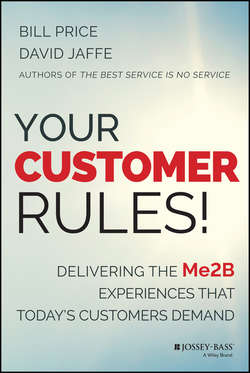Читать книгу Your Customer Rules! - Bill Price - Страница 12
На сайте Литреса книга снята с продажи.
Chapter Two
You Know Me, You Remember Me
ОглавлениеCustomers today demand to be recognized and known by the companies they do business with, throughout every interaction and every stage in the relationship. Companies that meet this need fulfill the first customer need for Me2B success, which makes all the others possible: You know me and you remember me.
Amazon, a customer experience pioneer, is without a doubt the most high-profile, end-to-end example of a company that knows and remembers its customers – and we don't only think that because Bill was Amazon's first global VP of customer service; the company's track record speaks for itself. Beyond fast shipping, low prices, and incredible selection, Amazon is famous for delivering great experiences. For example, unlike many other online retailers today, Amazon has always employed customer cookies (data stored in users' web browsers) to speed sign-in and enable customers to access their accounts with ease.
Unfortunately, despite all the progress in centralized customer databases, repositories, and interaction histories, most organizations today keep their information in separate silos and are unable to recognize their customers across all interactions or channels. In the good old days, the best of the local merchants or bankers or candlestick makers either knew all their customers by sight and by name or found a way to make it seem so. Customers rewarded these merchants with repeat business and favorable mentions to friends and family. Intimacy and personal memory allowed small companies to retain this knowledge of the customer. Even today, many local companies operate this way.
But for the majority of businesses, small has turned into giant, local into global, and personal into unknown, and companies have largely lost the ability to know and remember the customer. As organizations have grown, they have built and maintained customer data in separate repositories, sometimes with different markers that don't let them connect the dots. For example, they might show Clifford Smith in one database, Cliff Smith in another, and C. G. Smith in yet another. It's true that some companies do manage to cleanse their data so as to combine all three examples as one customer, but many don't know how to do it or don't even bother. Some companies even count these three variations as three different customers!
In the good old days of small and intimate organizations, there was less specialization into departments. People played multiple roles and therefore retained customer knowledge between interactions. Today, specialization has resulted in different employees knowing only certain details about the customer. Organizations today may not even remember the customer from interaction to interaction. They lack short-term memory, let alone long-term connections.
Success with “You Know Me, You Remember Me” goes beyond collecting data. Some organizations have been particularly smart in finding ways to use those data to serve customer needs. Even back in the good old days, not all shopkeepers remembered their customers well or exploited that knowledge. The same is true today.
Me2B Leaders – by no means just Amazon – are finding ways to cut across their departmental and product silos to deliver the consistent experiences that today's customers want. The Know Me, Remember Me need has many different facets, presenting many opportunities to embrace and satisfy your customer, as we'll explore in this chapter. In Table 2.1 we summarize examples when the need is met well and when it is not met.
Table 2.1 The Customer's Experience of Success and Failure
For an intuitive understanding of why this first customer need is fundamental to quality business relationships, simply look to personal relationships. “You Know Me, You Remember Me” is fundamental to life partners, parents and children, and friends. When partners share a mutual understanding of prior commitments, needs, desires, and history, it is much easier for them to connect and support each other in the relationship. Each of us wants to be appreciated, as well, and be able to say, “Thanks, you did what I asked you to do” or “I'm so glad that you remembered X (be that an anniversary or shared story).” In their 1996 research on long-term satisfying marriages, Kablow and Robinson determined that expressions of appreciation and communication were two of the seven crucial drivers of marriage success. Those processes both require knowledge of the partner and the things they are doing. The relationship research shows that knowing one's partner well enough to communicate with them and show appreciation of them is critical to success in relationships, and all these ingredients are needed to sustain customer relationships in the business world, too.
